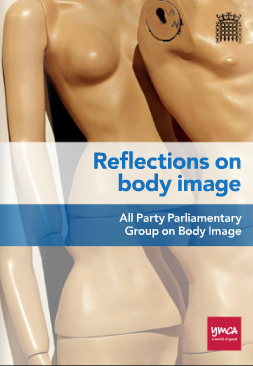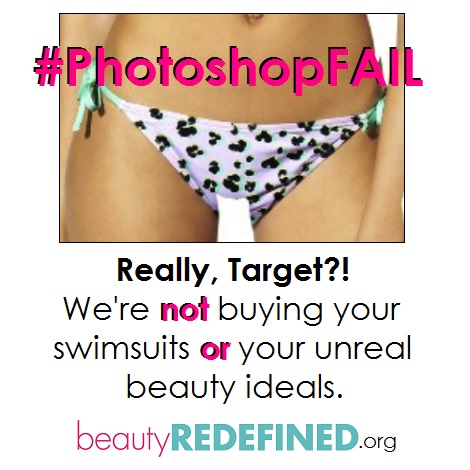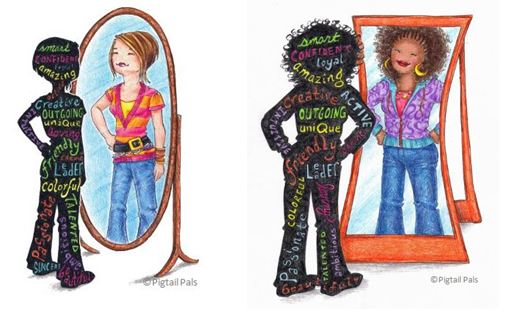May 3, 2016 Take Part! Seth Matlins gives an update on the status of H.R. 4445, and continues his worthy campaign for children’s wellness via this poignant post, “Dear Parents: Victoria’s Secret is Also Raising Your Child.” You can take action here to urge others to co-sponsor the Truth in Advertising Act, and follow Seth on Twitter using the #TruthInAds hashtag. (Image via Pigtail Pals & Ballcap Buddies)
April 3, 2014 Though the Congressional hearing went well according to Seth Matlins, (here’s the transcript from his presentation) I personally am disheartened that Time published a micro view vs a macro lens of the public health conversation, medical costs and long term implications for societal wellness to niche the conversation to being about “eating disorders lobbyists.” Predictable, but inaccurate.
Also, the pullquotes from (largely absent) ad industry representatives dismissively framed the substantive content of the bill to paint with broad brushstrokes misleading readers about the elimination of Photoshop vs the specific “material changes to bodies” verbiage in the bill.
It’s frustrating that mainstream media continues to turn away from the very real mental and physical health damage of hacking away at physiques to plop the payload on the FTC which, let’s face it, is not a watchdog in this ad arena, and certainly is not woofing or even lifting a lip in a curled up snarl. Hope they all look at the first ever Global Youth Wellbeing Index! (2:50m teaser video via CSIS, Center for Strategic and International Studies) to start to see the worldview from body image ‘exports’ of toxicity from the USA as well. When will critical thinking be applied and factual data reported over ‘sound bite’ coverage of misinformation with half-baked accuracy?
Original Post Mar. 25, 2014 “Teen girls are more afraid of gaining weight than they are of cancer, nuclear war, or losing a parent,” the headline ignited my media literacy fuse, “Hmn. Really? What teen girls? How many? Who was surveyed? Is this a HuffPo header for ratings bait?”
With today’s corporate mea culpas over “thigh gap” ad blunders (from Target’s “heinously cropped juniors’ Xhilaration brand bikini shots that looked like they were touched up with a pair of Playskool scissors”
to Old Navy’s nip and tuck fabric pinning without Photoshop to create a similar effect) that headline served far beyond hyperbole, revealing a statistical eye-opener of how body image expectations are damaging vulnerable populations of adolescent girls particularly, and now teen ‘buffed boys’ at an alarmingly accelerated rate.
A few quick clicks through the American Medical Association policy concerns over body image in advertising, as well as Center on Media and Child Health and Brandeis University’s ethical inquiry about photo manipulation in pursuit of beauty echoed the all too familiar dire stats in specialized spheres like eating disorders prevention about children’s wellness.
 According to this article in the Guardian, girls as young as five “routinely worry about their weight and appearance while more than half the entire UK population is grappling with mental and physical problems relating to negative body image” as evidenced by this 80 pp pdf of the recent published all-party parliamentary report in the UK.
According to this article in the Guardian, girls as young as five “routinely worry about their weight and appearance while more than half the entire UK population is grappling with mental and physical problems relating to negative body image” as evidenced by this 80 pp pdf of the recent published all-party parliamentary report in the UK.
They go on to say that the “pressure to achieve an unrealistic “body ideal” is now an underlying cause of serious health and relationship problems,’damaging society’ by wreaking havoc with self-esteem and affecting progress at school and work.” That’s quite a strong indictment.
Here in the U.S. even celebrities have grown concerned, as noted in this Huffington Post article, Is Photoshop destroying America’s body image? that cites Kate Winslet and Brad Pitt leading the pushback posse to request their digital bods not be messed with…
For parents especially, it begs the question:
At what point do we reframe the ambient media messages and toxic body image cues being sent to kids as a public health problem rather than an aspirational, appearance-based pop culture simply run amok?
As health educators, youth advocates, and parenting pros hand-wring from the escalation of harm pertaining to children’s physical and mental well-being, one has to ponder where the line is drawn between children’s rights and a gobsmackingly absurd lack of industry self-rein.
From media stories reflecting on the Thigh Gap: Teenage Girls Latest Obsession, to pundits giving a shoulder shrug with “Meh, so what can ya do?” helplessness or “tsk-tsk” blame games: “It’s up to parents to just explain that it’s not real to your kids,” it makes me wonder how long we’ll allow industry cash registers to go ‘ka-ching’ and kids’ psyches go ‘ka-boom.’
As a First Amendment, anti-censorship, ‘no fan of a ban,’ media literacy advocate, I’m stymied at how fast and furious we’ve spun out of control as a culture in terms of the kid gloves approach to corporate commodification of childhood, with a moral compass that’s gone “sproing” when it comes to the cost of putting profit over public health.
 I’ve always been circumspect about federal regulatory efforts based on overall lack of efficiency, oversight, and lousy enforcement performance, but at what point do we as a society throw down the gauntlet with a “Howard Beale” type of media battle cry that ENOUGH is enough?!
I’ve always been circumspect about federal regulatory efforts based on overall lack of efficiency, oversight, and lousy enforcement performance, but at what point do we as a society throw down the gauntlet with a “Howard Beale” type of media battle cry that ENOUGH is enough?!
We have to start somewhere, ANYwhere…The soul-eroding ambient messages bombarding kids with unattainable fixations are beyond gaffes and guffaws of how ‘silly’ and ‘unreal’ the ads and body image visuals are.
We can say to “use health literacy” and “teach what’s unreal” but sadly, it’s not making a dent fast enough with the 24/7 blitz of believability by the billions. As much as it pains me to say it, I’m beginning to feel no amount of media literacy will ‘fix’ the toll this is taking on kids’ wellness.
To deflect with a defensive shield on the usual cries of “kids’ protectionism” for those trotting out wrist-slaps as evidence of “industry self-rein” I’ll go on record as saying ‘we agree to disagree’ because I stand with the California Health Report on this one: Public Health Protections Are NOT A Sign of a Nanny State, no matter how many times that loaded phrase pops up.
 There’s a surreal gap (um, ‘thigh gap size) between industry’s promise of self-rein and the duplicitous perpetuation of advertising that is fouling up the works in children’s health statistics and mental and physical socio-emotional well-being…
There’s a surreal gap (um, ‘thigh gap size) between industry’s promise of self-rein and the duplicitous perpetuation of advertising that is fouling up the works in children’s health statistics and mental and physical socio-emotional well-being…
So I listened with open ears to hear about the proposed new “Truth in Advertising Act” which is transparently a ‘work in progress’ but a step in the right direction of giving the FTC watchdogs at least a sharpened tooth or two to get beyond a lip curl.
While it remains to be seen how the Truth in Advertising bill will fare, it seems its very existence slated for introduction imminently and a Congressional briefing April 3, 2014 should help turn up the heat in the national dialogue to ignite some industry rein.
Perhaps we can finally incite some corporate compliance beyond a clumsy “oops” on Photoshop hacks that have sliced and diced the bodies in their ads, and the image of what a body is in children’s minds, to begin to legislate a framework to move toward healthier body image policies that go beyond “suggestions” and pretty please verbiage to advocate for public health.
 The American Medical Association new body image policy (2011) “encourages advertising associations to work with public and private sector organizations to develop guidelines for advertisements, especially those appearing in teen-oriented publications, that discourage the altering of photographs in a manner that could promote unrealistic expectations of appropriate body image” but I’d assert this doesn’t quite go far enough.
The American Medical Association new body image policy (2011) “encourages advertising associations to work with public and private sector organizations to develop guidelines for advertisements, especially those appearing in teen-oriented publications, that discourage the altering of photographs in a manner that could promote unrealistic expectations of appropriate body image” but I’d assert this doesn’t quite go far enough.
The AMA specifies the problem well, “The appearance of advertisements with extremely altered models can create unrealistic expectations of appropriate body image. In one image, a model’s waist was slimmed so severely, her head appeared to be wider than her waist,” said Dr. McAneny. “We must stop exposing impressionable children and teenagers to advertisements portraying models with body types only attainable with the help of photo editing software.” Yes. And YES. But it seems like the industry ‘self-rein’ powers that be are either ’erasing’ it as fast as a Photoshop glitch from their mental relay and collective consciousness as a serious public health issue now harming kids, or they’re blowing off the Hippocratic oath, to “do no harm.”
Given the direct and indirect health care costs, a growing consortium of children’s advocates and public health professionals consider it’s high time to build on the dialogue with dollar-driven consequences.
Perhaps the forthcoming Truth in Advertising Act will pick up where the AMA policy leaves off, adding guidelines that spell out the no-nos so everyone is clear that hallpasses aren’t being given anymore. For starters, they’ve presented a first draft of what it is and what it isn’t, to specify they’re talking about “material changes” that create distorted and unrealistic expectations of appropriate and healthy weight and body image. Example?
Material changes are those “altering a person’s shape, size, proportion, body mass, skin color and/or the removal or enhancement of individual features (i.e wrinkles, eyebrows, eyelashes, lips, waistlines) or other similar characteristics made to the human body.”
 Hmn. Will the Truth in Advertising legislation spotlight repeat offenders with fines or fiscal measures? Shoulder shake compliance? Deter the “weapon of mass perfection” pointed at our youth that’s creating collateral damage in kids’ psyches?
Hmn. Will the Truth in Advertising legislation spotlight repeat offenders with fines or fiscal measures? Shoulder shake compliance? Deter the “weapon of mass perfection” pointed at our youth that’s creating collateral damage in kids’ psyches?
Are we as a society ready to take body image off the back burner and turn up the flame of corporate social responsibility to hold advertisers accountable?
Or have we all become too desensitized, unable to even reach a boiling point anymore with thick scars from being scalded and wounded that we’re unable to even SEE that we’ll be paying for these public health costs down the line?
As I’ve said so many times, “the price we pay to mine kids’ childhood will ultimately cost us all.”
Here’s my quick Q&A to attempt to glean a few answers with Seth Matlins, creator of the bipartisan body image bill coming up for discussion April 3, cited as the “Truth in Advertising Act of 2014.”
Shaping Youth, In Conversation with Seth Matlins:
Amy Jussel, Shaping Youth: How does this bill differ from what’s currently on the books, since the FTC is supposed to be protecting consumers from deception and fraud already. For example, do you feel the Truth in Advertising framework will give more teeth to the watchdogs? And since Photoshop is pretty much a verb these days, used by almost EVERY media outlet, is this based on “degree” of retouching or what? How does it differ from ‘twas ever thus’ types of alterations like high school photos, blemishes, etc.? Help us understand the nuances.
Seth Matlins: We’re focused singularly on advertising; because of the 1st Amendment, editorial can’t be touched, so we won’t fight a battle sure to be lost in terms of areas like Vogue’s Lena Dunham cover and/or any other editorial context.
Our concern and focus is not on ads that make a blue sky bluer, clean up a model’s fly-away hair, or frankly even remove a tattoo.
As we defined in the bill, “material changes” are: “only and specifically the alteration of a person’s shape, size, proportion, body mass, skin color, and/or the removal or enhancement of individual features (i.e., wrinkles, eyebrows, eyelashes, lips, waistlines) or other similar characteristics made to the human body.”
The FTC is being compelled by Congress (and with a to-come Senate companion bill) to exercise its mandate as the nation’s consumer protection agency, specifically Section 5 because:
a. These ads are false and deceptive
b. The direct link between these images in and consumer harm, specifically emotional, mental and physical health issues (which, in turn, create economic consequences)
c. Consumers rely on the images in these ads to make purchase decisions
A-C are the thresholds that are required to meet the FTC’s Central-Hudson standard.
Basically, if the bill gets introduced as we expect, the FTC will have 12-18 months to develop a legislative framework for advertising that makes material changes to the bodies and/or faces in them, using post-production techniques. It’s not an anti-advertising bill, nor a matter of encroaching on first amendment rights (part of why “editorial” is not included). This is nothing more nor less than a consumer protection and health issue.
Amy Jussel, Shaping Youth: So the FTC has 12-18 months to develop specific policy recommendations and remedies? How will it be enforced? What are the teeth to it? (e.g. is this a ‘tobacco warning’ style disclaimer or what?)
Seth Matlins: “Photoshopping” (as placeholder for whatever post-production techniques one uses) is an industries wide and everyday practice, as sure to be seen in a Chrysler ad as a L’oreal one.
Our concern and focus is NOT on ads that make a blue sky bluer, clean up a model’s fly-away hair, or frankly even remove a tattoo. As we expect to see it defined in the bill, we are focused on “material changes to the human body” and the bill draft defines “material changes” as: “only and specifically the alteration of a person’s shape, size, proportion, body mass, skin color, and/or the removal or enhancement of individual features (i.e., wrinkles, eyebrows, eyelashes, lips, waistlines) or other similar characteristics made to the human body.” Advertisers can Photoshop a blue sky bluer, or clean up fly away hair or do anything else they choose, that’s just not our concern.
So yes, one could imagine disclosure labeling, ratings, media limitations (i.e. No out of home ambient ads that “spill” into a child’s life with digital alterations, like outdoor/transit ads, back pages etc.) Basically, solutions that provide a framework for curbing these mass digital distortions…
Amy Jussel, Shaping Youth: I’m not sure we can ‘legislate’ ethics/corporate social responsibility when it comes to public health (gawd knows we have tried in the junk food marketing to kids’ sphere to no avail, with lobbyists often over-riding food and beverage oversights and carving up policy to where it’s muddled and torn and parents think it’s been ‘handled’ in schools, but it hasn’t.)
Sooooo…How do you see this circular silo of intent vs positive/sustainable change from a doability standpoint? Or is it more like a ‘perceived threat’ of enforcement like the transparency mandates of nutrition labeling and CSPI’s improvements to advertising as watchdogs?
Seth Matlins: You’re absolutely right…we can’t legislate ethics (as gun control, junk food, etc show quite clearly) BUT we can use an ethical and moral imperative to create new laws and/or that inform past-due self-regulation as we push for concrete and measurable reform. That’s exactly our intent…sustainable, meaningful change that recognizes that advertising’s current status-quo is at the root of an epidemic of bad and that it has to change.
We have a moment and an opening and I’m going to get all bull in a china shop with it until a better idea comes along and then I’ll be 100% on-board with that. Until then, we’re asking the FTC to exercise its mandate as America’s consumer protection agency to do just that.
From here, the real grassroots action will be bringing scale to the voices of the people who know business as usual can’t stay that way, and are ready and able to use this bill to get the FTC and industry to act and to change.
Amy Jussel, Shaping Youth: What are some of the costs associated with the bill?
Seth Matlins: We think the costs associated with the FTC’s implementing the bill are so minimal that they’ll get a zero score from the Congressional Budget Office. You’ve outlined some of the societal costs, I plan to present some of the economic damages of all this as measured by:
– Direct and indirect healthcare costs, as well as the costs to GDP because of an unhappy workforce which Gallup puts at over 300B annually
– The $2.3 Trillion that the current US population of women are projected to spend over their lifetimes on cosmetics (based on a $15k average), convinced at least in some part by these deceptive and Photoshopped ads. All this is before we even consider the costs of elective and cosmetic surgeries inspired by false and unrealistic images and expectations.
We’ll be putting out a discussion guide and campaign toolkit along with a grassroots petition (on April 7th) to get things started, and to support the policy-based initiative. Advocacy organizations and supporters can sign up here to add their names to common sense legislation/regulation as outlined using the hashtag #TruthInAds as progress develops.
Though you’ll no doubt recognize some of the partners, it’s absolutely not a singular issue about body image, adolescents, or even eating disorders (and the Eating Disorders Coalition has been a key partner in getting this to Congress)…It applies to women and girls of course, but also to men and boys who are also being damaged emotionally, mentally and physically by these image alterations at an accelerated rate.
This is a large scale public health issue. We welcome support by doctors and medical professionals, academicians, ad executives, and anyone who can help us further illustrate the direct link between advertising’s influence and the damage being done to kids. The time has come to address it. Please spread the word and join us! The support of anyone who thinks the time for change is past due is welcome and appreciated.
Amy Jussel, Shaping Youth: Done. Thanks for helping to clarify “what it is and what it isn’t” I look forward to seeing how it develops and asking some other adolescent health allies aboard!
As this blogger summed in “that was then, this is now” youth insight:
“It was one thing when we used actual models with genetics that put their body type out of reach for most of us…But Photoshop has taken this thing to whole new lows of unreachability. Real people just don’t look like that. It’s seriously messed up.”
Visual Credits: Special thanks to our Brave Girls Alliance colleagues at Beauty Redefined.net for their thigh gap and fact focused graphics/visuals, and to Pigtail Pals and Ballcap Buddies for the fabulous “Two Reflections” lead photo (which is even in a tee!) Again, you can sign on your support at the Brave Girls Want site and follow the hashtag #BraveGirlsWant in addition to #TruthInAds as the bill develops. Also, thanks to @SaritPhoto for her “weapons of mass perfection” coinage on Twitter, that’s a keeper, so apt, and to Seth Matlins for debriefing me on short notice before this bill hits “The Hill.”
Fresh Reading/Resources: Media Influence on Body Image
AMA Jan. 2014 Study/Boys: JAMA Pediatrics
Jan. 2014: Teen Boys Who Think They’re Skinny May Be At Higher Risk for Depression (Health Day News)
Mar. 19, 2014: Fresh Stats from GirlGuiding UK, launching ‘body confidence’ badge (The Guardian)
Mar. 10, 2014: Body Image Pressure Increasingly Affects Boys (The Atlantic)
Mar. 11, 2014: How Movies Fuel Boys’ Insecurities (Time)
Feb. 26, 2014: Necks, Butts Growth Areas for U.S. Plastic Surgeons (Health Day News)
Feb. 26, 2014: Kids’ Body Image Shaped By Parents (Health Day News)
Fast Facts: Teen Health and the Media (National Institute on Media & Family)
Media Literacy Infographic: Media and Body Image (NEDA)
Infographic/Stats: Girls and Media (NEDA) Boys and Media
Stats Compilation Below Via “Just Say YES: Youth Equipped to Succeed”
- 40% of all 9 and 10-year-old girls have already been on a diet – Duke University
- 70% of 6-12-year-olds want to be thinner – National Eating Disorders Association
- In one study, 3 out of 4 women stated that they were overweight although only 1 out of 4 actually were – Rader Programs
- While only one out of ten high school girls are overweight, nine out of ten high school juniors and seniors diet – Rader Programs
- A study found that adolescent girls were more fearful of gaining weight than getting cancer, nuclear war or losing their parents – Rader Programs
- Teen pregnancy statistics show that girls who engage in unprotected sex often have lower self esteem – Family First Aid
- 69% of girls in 5th – 12th grades reported that magazine pictures influenced their idea of a perfect body shape – National Association of Anorexia Nervosa and Associated Disorders
- Following the viewing of images of female fashion models, seven out of ten women felt more depressed and angrier than prior to viewing the images – Rader Programs
- 80% of women who answered a People magazine survey responded that images of women on television and in the movies make them feel insecure – Rader Programs
- The body type portrayed in advertising as the ideal is possessed naturally by only 5% of American females – National Association of Anorexia Nervosa and Associated Disorders
- An average US woman is 5’4” tall weighing 140 pounds; the average US model is 5’11” weighing 117 pounds – West Virginia Dept of Education









Women have been saying this stuff for YEARS. Now a man comes along and states the obvious, and NOW it gets national attention? Because women and girls weren’t people before he had a daughter and now of a sudden he cares?
This bill should be called Men: Getting National Recognition and Praise for Doing the Bare Minimum.
Interestingly enough, I’ve seen that exact same comment on multiple blogs…are you a bot? Or a troll? Either way, my reaction is the same…Men (and boys) are a huge part of this conversation in change making and in order to create a sustainable, systemic overhaul of these mass contrived perceptions, we need “all hands on deck”…On a personal note, I have worked with Seth via the Brave Girls Alliance and have seen his commitment and dedication goes far beyond lip-service, so he’s a welcome voice in this battle against objectification toward a healthier future for ALL kids (not just girls, either, this is a societal issue) These body image issues are impeding the mental health/wellness of young men as well-> https://shapingyouth.org/boys-body-image-and-sexualization-an-equal-opportunity-destroyer/ I’ve written a lot about this dynamic too if you ck out the ‘body image’ archives about “packaging boyhood” and the buffed boy/hottie hoopla. #justsayin
Women have been saying this stuff for YEARS. Now a man comes along and states the obvious, and NOW it gets national attention? Because women and girls weren’t people before he had a daughter and now of a sudden he cares?
He’s been saying it for years too…quite the gender equity advocate, actually…not a newbie by any means.